*Secrets of the Basic Qigong Techniques for Wall-Meditation by Bodhidharma*
【General Steps: Foundation Building — Qi Circulation — Qi Stabilization — Qi Emission — Spirit Cultivation (Light Emission, Remote Collection) — Intent (Wall-Meditation)】
Comprehensive Practice Schedule for Health Preservation and Defense (Based on One Month)
Days 1 to 3
Qi Emission — Standing Post — Qi Collection — Qi Testing — Friction — Closing Form (End)
15 times 3 minutes 10 minutes 2 minutes 10 minutes 3 minutes
Days 4 to 7
Qi Emission — Relaxation — Qi Collection — Qi Testing (Swallowing Qi) — Friction — Closing Form (End)
20 times 5 minutes 10 minutes 2 minutes 10 minutes 5 minutes
Days 8 to 11
Qi Emission — Qi Discharge — Relaxation — Qi Collection — Swallowing Qi (No Testing) — Friction — Closing Form (End)
10 times 10 minutes 1 minute 5 minutes 1 minute 10 minutes 5 minutes
Days 12 to 15
Qi Emission — Qi Discharge — Qi Collection — Swallowing Qi — Friction — Closing Form (End)
10 times 10 minutes 3 minutes 1 minute Gather Qi in the Abdomen 3 minutes
Days 16 to 30
Qi Emission — Qi Discharge (Chest and Abdomen Practice Together) — Relaxation — Swallowing Qi — Friction (Lower Dantian) — Closing Form (End)
5 times 20 minutes 1 minute 1 minute 20 minutes 3 minutes
The above is a practice schedule for healthy individuals. Following this schedule and method for one month will enhance bodily functions and resistance. After that, practice can be arranged freely.
If there are existing health issues, targeted individual practices are required, and the methods will differ. If a certain level of practice is reached and disease elimination is achieved, the above schedule can be followed to consolidate results and improve physical quality and resistance.
(Official Material) Basic Internal Qigong
Qi Emission Technique (also known as Golden Bell Shield, which is the first item in the above schedule, this method can be practiced alone)
Preparation Position: Stand naturally, feet shoulder-width apart, arms relaxed at the sides, head facing forward, breathing calmly (as shown in Figure 1).
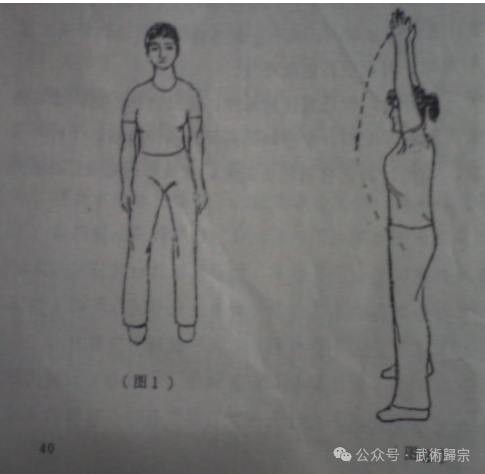
First Posture (Suspended Bell): With palms facing down, raise both arms vertically forward and upward, using elbow strength to lift the chest muscles, pulling the chest and abdomen. At this moment, the chest protrudes and the abdomen retracts, coordinating with inhalation through the mouth, inhaling long and thin, as much as possible until no more can be inhaled, while the abdomen sinks down, imagining the Qi in the abdomen rising to the chest, filling the chest completely, as shown in Figure 2.
Second Posture (Bell Cover): Following the previous posture, turn the palms upward, separating them to the sides while holding the breath, pausing for a moment, imagining the chest Qi is sufficiently fixed in the chest. As shown in the figure.
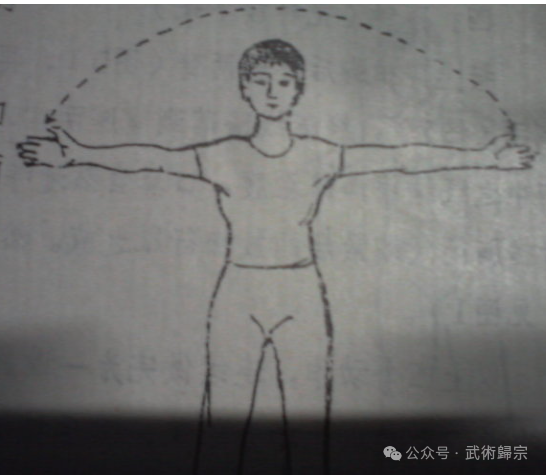
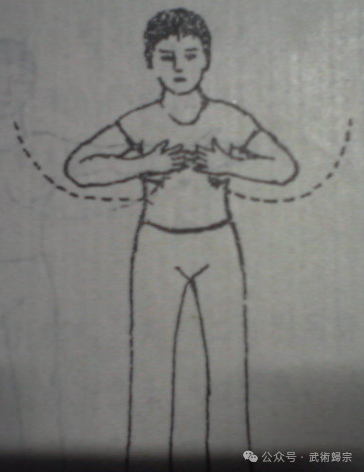
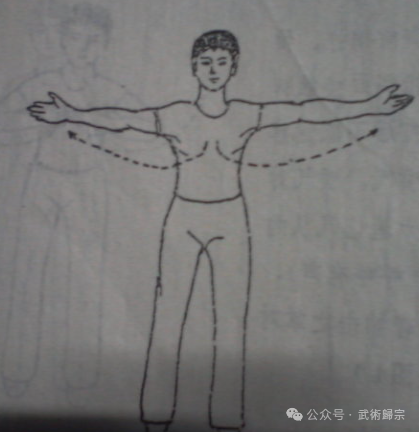
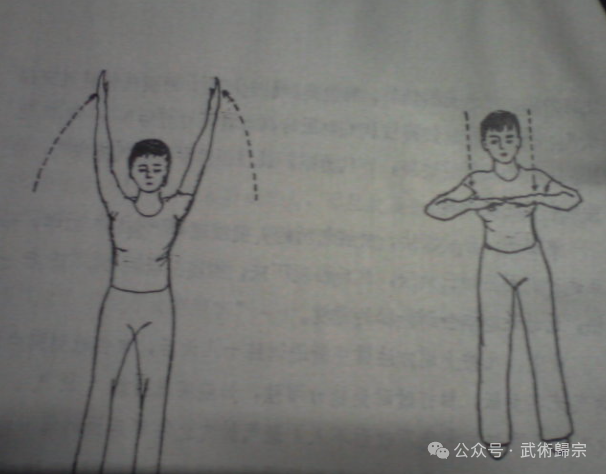
Third Posture (Bell Strike): Both palms clap together in front of the chest, with the palm surface or the little finger side contacting the chest, applying moderate force, and after striking, there should be no pain. This is coordinated with Qi emission, where the Qi is forcefully expelled from the mouth or nose, imagining the Qi in the chest bursting forth upon contact with the palms. One breath can strike once to three times. As shown in Figure 4.
Fourth Posture (Bell Drop): After striking the chest, separate the arms and circle from the outside to the inside, from top to bottom to the sides of the abdomen (returning to the preparation position), gradually releasing the remaining Qi from the chest, relaxing the whole body. As shown in the figure.
The above four movements performed continuously constitute one round, and each practice should be repeated seven to thirty times as appropriate. After completing this form, proceed to the Thousand-Hand Guanyin Qi Collection. This method can also strengthen the body, and long-term practice is beneficial for the chest and lungs. There have been cases of lung cancer patients who persisted in practicing this method for six months and recovered from cancer, continuing to practice and still working today. This method not only enhances the resistance of the chest muscles but also benefits the digestive function; patients with digestive issues can also achieve good recovery through regular practice.
Thousand-Hand Guanyin Qi Collection
Preparation Position: Loosen the belt, feet shoulder-width apart. Slightly lower the hips, head slightly up, chin slightly retracted, neck relaxed, smiling gently, eyes lightly closed, tongue against the upper palate, shoulders relaxed, chest slightly concave, arms hanging naturally at the sides, the whole body should feel comfortable and not stiff or awkward. This posture is also called standing post. This is just the surface appearance; to achieve complete relaxation, one must relax from the inside out. While adjusting this posture, breathe lightly in and out, imagining the whole body relaxing step by step from top to bottom or from bottom to top. To enhance this effect, one can silently repeat the word “relax” several times until a true sense of relaxation is felt. As shown in the figure.
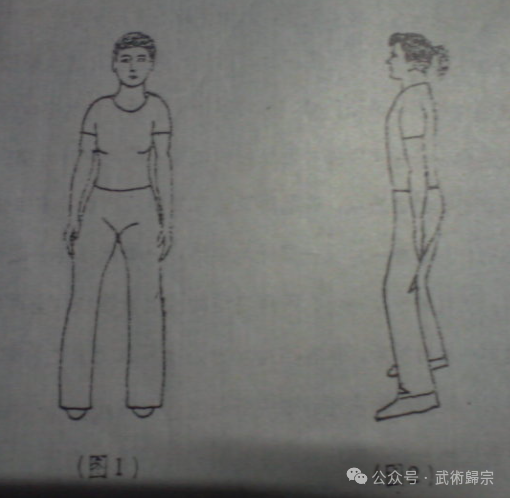
1. Palm Absorbing Earth Qi
After achieving relaxation, slowly extend both hands forward, palms facing down, without exerting force, at shoulder height or slightly lower. Silently repeat, “My palms absorb the Yin Qi of the earth, the earth’s Qi continuously enters my palms, flowing in endlessly, coming in…” Repeat silently for three to five minutes. As shown in the figure.
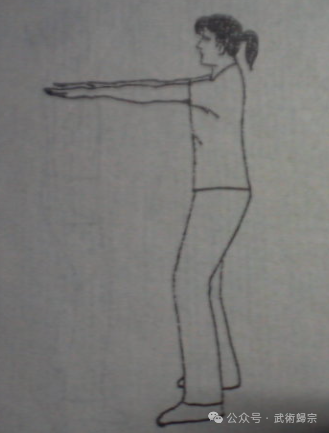
2. Palm Pushing into the Earth
Lower the extended arms to the sides, bending the palms (not too tight), palms facing the ground, silently repeat, “My palms extend downward, extending down, extending down, reaching the ground, touching the earth, absorbing all the earth’s Qi into my palms, my palms are filled with Yin Qi, having the strength of a thousand pounds.” On the basis of relaxation, repeat silently several times for three to five minutes. As shown in the figure.
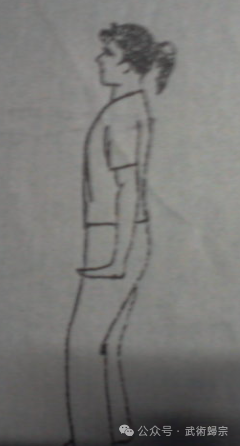
3. Palm Absorbing Sky Qi
Following the previous posture, slowly return the palms upward, as if holding something, arms gradually raised to shoulder height. Silently repeat, “My palms absorb the Yang Qi from the sky, the sky’s Qi continuously enters my palms, flowing in endlessly, nourishing my palms.” Repeat silently several times. As shown in the figure.
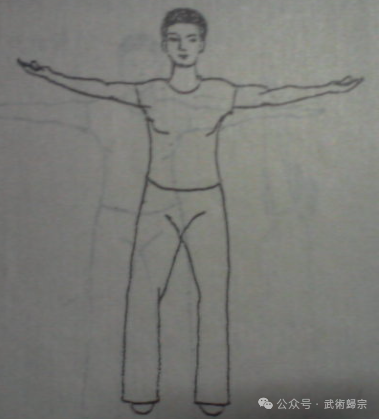
4. Hands Reaching for Qi
Continuing from the previous posture, extend both arms outward, palms still facing up, fingers extended, as if begging from the sky, silently repeat, “Heaven above, my heart is sincere, my hands connect with the sky, spanning thousands of miles, sweet rain and dew, shower upon my hands, the sun, moon, stars, light all absorbed into my palms.” When the Qi comes to the palms, sensations of heaviness, numbness, or pulsation may be felt, persist for three to five minutes.
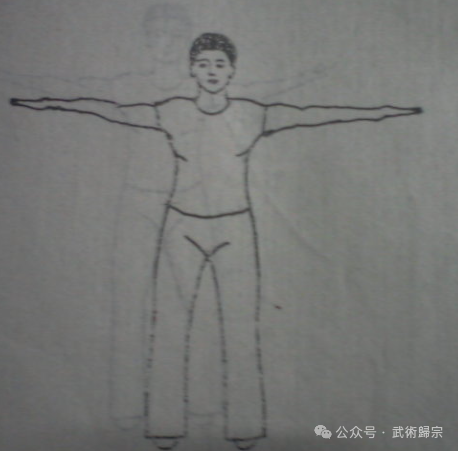
5. Yin and Yang Opposing
Slowly move the extended palms above the head, arms perpendicular to the top of the head, palms facing each other. After practicing this for a while, sensations of heat or cold may be felt; sensitive individuals may feel this after three to five days. Once in this position, silently repeat, “I stand on the earth, my hands support the sky, my feet absorb the Yin Qi from the earth, my hands collect the Yang Qi from the sky, my palms are filled with blood Qi, my fingers connect to the heavens, my palms support the sun and moon, balancing Yin and Yang.” Persist for three to five minutes; if time allows, continue until a sensation of heaviness or numbness is felt throughout the body. As shown in the figure.
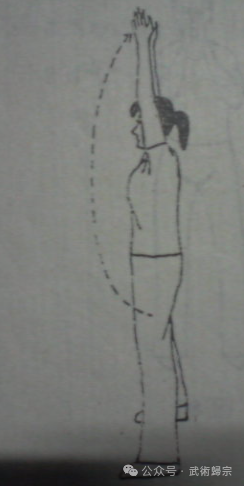
6. Opening and Testing Qi
Following the previous posture, lower both hands to the Tianmu point (the area between the eyebrows), ensuring the hands do not touch the face. Eyes remain lightly closed, imagining that the Qi from heaven and earth has been received, harmonizing Yin and Yang, transforming into a transparent sphere, about the size of a basketball, in front of the eyes. Then gently press the palms against this Qi sphere, pressing it flat and releasing, rubbing several times. Generally, sensitive individuals will feel a pushing or pulling sensation between the palms after three days of Qi collection.
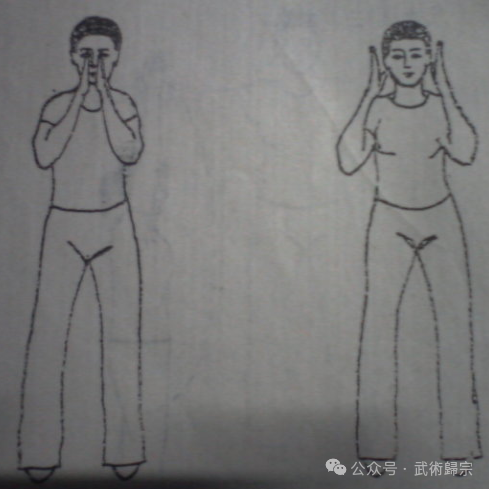
7. Palms Together in Gratitude
After feeling the Qi in the palms, bring both palms together in front of the sky, silently repeat, “Heaven has the virtue of nurturing life, grant me sweet rain and dew, sun, moon, and starlight, my heart is grateful, thank you, heaven.” After completing this, gently move the joined palms to the mouth, inhaling deeply through the gap between the thumbs, imagining absorbing the Qi from the palms into the mouth, filling the mouth, holding it for about a minute, then raising the head, extending the neck, swallowing, making a sound as the Qi and saliva are sent to the lower Dantian, with the palms following the intention moving down, thus guiding the Qi inward to the “Zhong Dantian,” the central part of the body, between the heart and abdomen, where the palms rest gently on top of each other. During the swallowing process, do not exert force; the swallowing should be smooth and natural, in harmony with the saliva.
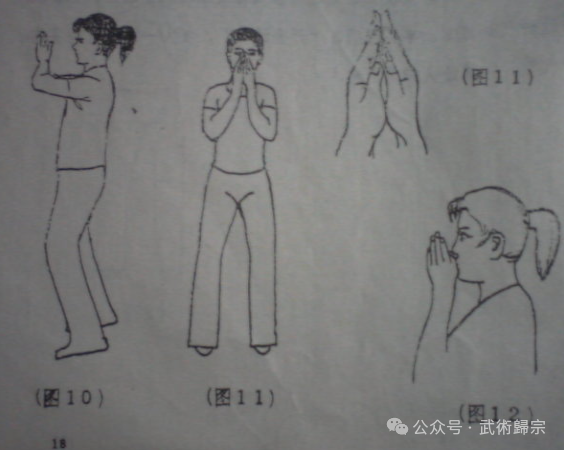
8. Buddha’s Heart Qi Gathering Technique (This technique is suitable for the subsequent various disease-eliminating practices)
After swallowing the Qi into the heart, maintain the Qigong posture, keeping relaxed, regardless of whether standing or sitting, do not change the posture. Regardless of any insect bites or itching from Qi absorption, abandon all distractions and focus on the heart. This heart focus is the Qi mass swallowed earlier. Cover it with both hands, close the eyes and visualize it, thinking about it, listening to it, as if this Qi mass is a “fire elixir,” then coordinate with full breathing, gently blowing towards the fire elixir. During breathing, do not focus on the mouth and nose, but concentrate on the heart’s fire elixir being blown brighter and brighter, the flames becoming more and more vivid. Each time blow several times, for about 20 minutes to complete. It is important to note: blowing should not be forceful; intention is sufficient, it should be gentle and quiet.
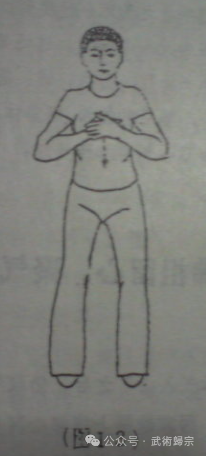
Basic Skills for Emitting External Qi
1. Horse Stance Sword Point Technique
Stand in a horse stance: feet apart, three feet wide, toes facing forward, do not stand in an outward eight shape, do not move randomly. There are three height requirements for squatting, namely bending the knees at 90 degrees, ensuring the knee projection does not exceed the toes. This stance is called a low stance, which is generally difficult for beginners and requires gradual progression. Start with a medium or high stance; regardless of the stance, do not move randomly. Once in position, lower the hips, pull the buttocks forward, relax the shoulders and back, keep the head upright, eyes looking straight ahead. The tongue should touch the upper palate, the neck relaxed, the chest and abdomen relaxed, the waist natural, and both hands extended forward. Palms facing down, bend the ring and little fingers, extending the index and middle fingers, this is called “sword point.” While straightening the sword point, maintain the horse stance without moving, focusing the mind on the sword point. When the sword point feels swollen, numb, or warm, it indicates that Qi has reached the fingers. At this point, the sword point can be slightly bent, and continue to hold; with regular practice, the sensation of Qi in the fingers will become easier to achieve.
2. Opposing Finger Circulation Technique
In a Qi collection posture, with eyelids drooping, gently raise both hands in front of the chest as if holding a Qi ball, keeping a distance of 3 to 5 centimeters between the fingers, focusing on the fingertips. First, imagine the right fingertip sending Qi, until sensations of numbness, swelling, heat, or pulsation are felt, then imagine the right fingertip emitting Qi towards the left fingertip — wrist — elbow — arm — shoulder — right shoulder — right arm — right elbow — right fingertip. This counts as one round; continue for 108 rounds, then close the practice, guiding the Qi back to the Dantian. You can also practice left to right. After practicing for two to three months, the sensation of Qi will become evident, and then proceed to the next technique.
3. Tree Circulation Technique (Qi Penetration Method)
Practice in front of a pine tree, standing one foot away from the tree, using the same opposing finger circulation method, ensuring the fingers do not touch the tree trunk, practicing with the intention of Qi penetrating through the tree trunk in a circular motion. This can also be practiced alternately left and right; over time, as you become proficient, you can treat illnesses through walls.
Self-Experiment of Emitting External Qi
After practicing for a period, you can use the fingertips emitting external Qi towards the palm of the other hand; when the emitting fingertip feels swollen or numb, the other palm will feel warmth, coolness, or numbness. You can also find a partner of the opposite sex to experiment with emitting Qi towards their palm. It should be noted that a small amount of external Qi is not sufficient to treat illness; deeper mastery is required for effective treatment.
Enhancing Intelligence and Vision (Treatment for Myopia)
Technique: 1. First practice the Thousand-Hand Guanyin Qi Collection for five minutes until the magnetic sensation in both palms is evident. 2. Align the Laogong point with the eyes, about three centimeters apart, imagining the Qi from the palms entering the eyes, connecting the Qi from the palms with the eyeballs, for one minute. 3. Slowly pull the palms outward in a straight line, stopping at about 10 to 15 centimeters, feeling that the Qi between the palms has not detached, then slowly bring the palms back towards the eyes, repeating this opening and closing for 20 times. 4. Hold the palms in front of the eyes, emitting Qi for one minute. 5. With both palms facing the eyeballs, gently rotate, moving the eyeballs to the left for 20 times and then to the right for 20 times. These actions should be done with eyes open. 6. Lightly close both eyes, rub the palms together 50 times until they feel warm, then gently stroke around the eye sockets 10 times, lightly pressing and rubbing the center of the eyes from inside to outside 10 times, and then from outside to inside 10 times. 7. Use the fingers to massage the Yuyao point, Sibai point, Sizhukong point, and Jingming point, each for 20 times. Finally, pinch the earlobes for 20 times. 8. Then gently cover both eyes with the palms, intending to guide the Qi from the Dantian to the eyes, rotating clockwise and counterclockwise for 20 circles each. 9. Remove the hands and slowly open the eyes, focusing on an object from near to far until it becomes clear.
Note: To treat myopia, one must also maintain the main eye health; otherwise, the effects will be unstable.
Simple Effective Exercises for Disease Elimination (Each item can be practiced individually)
1. Galloping Horse Vibration Technique
Concept: For those who sit in offices or have low physical activity, blood circulation may be slow or even blocked. Just five minutes of this technique is like riding a horse, urging it to gallop, causing the whole body to move and accelerating blood circulation. This technique is also suitable for those who find it difficult to remain still, especially many Qigong practitioners who cannot achieve stillness; this technique is excellent for full-body movement.
Indications: Cold deficiency, low blood sugar, lower back and leg pain, coldness in the heart and abdomen, difficulty in warming up, neurasthenia, dizziness, palpitations, tinnitus, fatigue, and weakness.
Action Essentials: Stand naturally, hands lightly covering the heart and abdomen, eyes gently closed, visualizing a fireball in the heart, shifting the weight to the heels, relaxing the toes and the center of the feet, slightly concaving the chest and back, and sitting back slightly, relaxing all other parts of the body. Then intentionally vibrate the thighs up and down, as if riding on a horse, allowing it to bounce up and down, gradually increasing speed and intensity. When warmth and slight sweating are felt, slow down and gradually stop.
Breathing and Intention: Allow it to be natural, without additional intention.
Note: Those with prolapsed stomach or rapid heartbeat should avoid this technique.
2. Embracing Qi Returning to Heart Cocoon Movement
Concept: Facing heaven and earth, the person is in the Qi, embracing the Qi, which encompasses mountains and rivers, all entering my embrace. Heaven is me, I am heaven, unity of heaven and man, moving together. The whole body moves like a dragon, each segment moving, massaging the chest and abdomen.
Indications: Weak digestive system, lower back pain, shoulder and arm pain, kidney cold and Qi deficiency.
Action Essentials: Stand relaxed, arms hanging at the sides, begin by pushing forward with the tailbone, moving forward segment by segment from the tailbone to the lumbar spine, when reaching the thoracic spine, the tailbone should be in a backward position, continuing to push forward, then the cervical spine pushes forward, even the forehead moves forward, creating an S-shape with the body. Thus, push from top to bottom and from bottom to top, also in a circular motion from outside to inside and vice versa, repeating this for 10 times as one round. This method can be practiced whenever there is time, not necessarily 10 times each time; two or three times is also fine, regular practice is beneficial for the body.
Breathing: Inhale deeply through the nose while embracing the Qi and leaning back, exhale lightly through the mouth while returning to the heart. Repeat practice until the movements and breathing are naturally coordinated.
Intention Coordination: Exhale turbid Qi, inhale Qi back to the Dantian.
3. Left and Right Looking and Twisting Technique
Concept: This differs from the previous embracing Qi returning to heart, focusing on the waist, hips, chest, abdomen, and neck. This method has been popular abroad and in Hong Kong and Macau, curing various chronic diseases.
Indications: Rheumatic joint pain, heart and lung blockage, chronic diseases that are difficult to recover from, neurasthenia, tumors, and cancer.
Action Essentials: Stand relaxed, arms hanging naturally, using the waist and hips to sway the upper body left and right, with the arms swinging correspondingly to the side of the body, even swinging behind, while the head follows the movement, looking back. Alternate left and right.
Breathing Essentials: With each left turn of the head, inhale rhythmically through the nose twice, then exhale as the head turns forward. Repeat this process, maintaining the rhythm: left inhale, inhale, exhale, flat; right inhale, inhale, exhale, flat.
4. Law Wheel Constantly Turning Technique
Concept: Qi enters the body, or in nature, will form a Qi vortex, creating pressure. By guiding this pressure towards acupoints, we can achieve healing and strengthening effects. In Buddhism, this rotation is referred to as the Law Wheel.
Application: This method can be used before and after each practice to guide Qi back to the Dantian, enriching the Dantian, and can also be used to adjust Qi in the Baihui point of the head or to open the heavenly gate and attack disease sites.
Action Essentials: Dantian Law Wheel: One hand lightly covers the Dantian, the other hand palm facing inward, starting about three centimeters away from this hand, making small rotations, first clockwise from small to large, from inside to outside, making 36, 72, 81, or 108 circles. The circles should be small to the original center and large to 30 centimeters, guiding the Qi, moving in harmony with intention. Then reverse the process, making large to small circles from outside to inside back to the center. This method is suitable for beginners to cultivate Dantian Qi; Qigong masters can also use it to open the heavenly eye, enhance wisdom, and treat diseases.
Breathing: Allow it to be natural.
Intention: Follow the rotation, allowing the Qi to flow with intention.
Spiritual Energy Impulse Buddha Worship Technique
Introduction: Practicing this technique requires a clear mind and minimal desires during practice, avoiding all stimuli.
1. Purification into the Empty Door
Posture: Stand freely, feet do not need to be apart, there are no specific requirements, just stand comfortably, arms hanging naturally, eyes gently closed, smiling, with thoughts free of attachments and desires.
Breathing: Natural, no emphasis.
Intention: 1. Focus attention on the feet, internally visualize the Yongquan point of the right foot slowly opening like a mouth, after half a minute, visualize the left foot’s Yongquan point opening similarly. Finally, visualize both feet’s Yongquan points opening together for one minute. 2. Then focus attention on the top of the head, internally visualize the Baihui point opening like a skylight, the clear Qi from above flowing in through the opened heavenly gate, forcing the turbid Qi within the body to be expelled through the opened Yongquan point down to the earth’s depths. After several minutes of this intention, feel the whole body filled with positive Qi, then proceed to the next technique.
2. Buddha Worship Revealing Spiritual Energy
Maintain the previous posture, shifting 70% of the weight to the heels, leaving 30% between the toes and the balls of the feet, with the front three and back seven, then bring the palms together, pressing the roots of the middle fingers together, arms horizontal in a prayer position. Key points: Relax the whole body, keep the palms pressed together. As spiritual energy comes, maintain this posture.
Silently repeat the heart method: I float up, detached from the mundane world, free from disputes, becoming thoughtless, emptiness is me, I am emptiness, the blue sky above, the clouds beneath my feet, floating freely, enjoying freedom in the air, worshiping ancestors in the western heavens, Bodhidharma grants me relics, spiritual energy flows through thousands of miles. Repeat this silently, persisting for over 20 minutes, with the body and mind relaxed, calmly waiting for a signal from any part of the body, indicating the arrival of spiritual energy. When spiritual energy appears, practitioners may exhibit a series of unusual movements, such as punching or dancing. If any movements occur, do not stop them; allow them to express freely, and when they gradually calm down, then close the practice and guide the Qi back.
Effects: Regular practice of this technique can strengthen the body, treat various chronic diseases, and stimulate the body’s potential.
Basic Hard Qigong Section
Self-Sealing Acupoint Emission Method
Gathering Qi Sealing Method:
Principle: This refers to the commonly used Iron Shirt method of Qi, which is also a relatively secretive method. The so-called Qi is the inherent potential shared by all humans. As long as the true essence is revealed, I will tell you how to use the Qi in your body to gather and seal acupoints in designated areas, inducing your internal potential to be activated in specific areas, thus achieving your emission, which will immediately generate a unique, extraordinary capacity for endurance and explosive power, capable of withstanding knife cuts and heavy blows. However, achieving this requires diligent practice for a period, at least building good muscle strength; otherwise, even if one can perform general demonstrations, the practical value is limited, and the endurance will be very restricted.
Three Adjustments: Adjusting Body, Mind, and Qi. Adjusting Body: This means adjusting the body’s position. The correct position is the premise for correct emission, allowing for coordination of all directions, preparing for proper Qi adjustment. Adjusting Mind: Eliminating fear, being indifferent to everything, even in the face of knives and guns, remaining calm and composed. Adjusting Qi: Adjusting Yin and Yang Qi. Here, Yang Qi refers to external Qi, while Yin Qi refers to internal Qi. Taking the chest as an example, use the mouth to pronounce the word “belly” while taking a long, thin inhalation, sending the Qi to the chest, which is the concentration of Yang Qi. Pull the chest and abdominal muscles up, opening the door for Dantian Qi, at this time the abdomen retracts, intending to send Dantian Qi to the chest, which is the concentration of Yin Qi. It is particularly important to note: when gathering Qi, the input of Yang and Yin Qi must be synchronized, not one after the other.
Chest and Abdomen Sealing Training and Testing (i.e., Emission Method and Efficacy Verification)
Training: 1. Gather Qi and seal acupoints, following the above method to concentrate Yin and Yang Qi in the left chest, retract the abdomen and puff out the chest, inhale deeply and hold the breath. 2. Raise the left palm and use it to strike the chest, starting lightly and increasing to a moderate force, ensuring it does not cause significant pain; one can first strike 30 to 50 times lightly, then strike harder three to five times while holding the breath. 3. After stopping the strikes, gently exhale the turbid Qi, gradually relaxing the body, while guiding the Qi back to the Dantian. 4. After a brief pause, gather Qi and seal acupoints again, increasing the strength and number of strikes as training time increases. After each breath, strike 20 to 30 times, repeating this for three times a day. 5. The same applies to the right chest. 6. Over time, gradually expand the striking area to the abdomen. 7. During the striking process, start with the palm, gradually transitioning to a wooden stick, and then to an iron rod. After practicing for over a month, one can complete the test of withstanding knife cuts to the chest without injury.
Testing: Remove outer clothing, stand in a T-pose, gathering Qi and sealing acupoints at the area to be demonstrated (left or right chest). Be confident and do not lose heart. Then, either self or with someone else, lightly strike the chest with a kitchen knife two to five times, or place the knife vertically on the left chest, avoiding the collarbone, then use the right hand to strike the back of the knife with a certain force three to five times, then close the practice. Closing: Gently pat the area that was struck with one palm, then use the palm to gently rub from the inside out in 49 circles, then reverse and rub back to the original point, finally guiding the Qi back to the Dantian.
Testing Notes: 1. Testing after drinking alcohol is strictly prohibited; 2. The area must be accurate; for knife tests on the chest, the area should be within five inches around the nipple, avoiding areas without Qi; 3. Do not use a serrated knife or a curved knife; 4. During the strike, it should only be a single, elastic strike, not dragging or pushing, and no swinging motion should occur.
Luohan Top Qi Technique (Iron Head Technique)
Practicing this technique can effectively protect the brain and improve shock resistance. Specific methods:
1. Top Qi on the Head
1. Adjusting Body: Stand naturally with feet shoulder-width apart. Or stand in a Qigong posture, with the left hand hanging down, the right hand upright in front of the Dantian, in a celestial position, relaxing the whole body, eyes naturally looking straight ahead.
2. Adjusting Mind: Focus on the Dantian, internally visualizing the feeling of the Qi mass rising.
3. Adjusting Qi: Pronounce the word “belly” while taking a deep, long inhalation, making a sound while inhaling, simultaneously intending for the Dantian Qi to rise to the chest and throat, inhaling as much as possible, with the right hand guiding the Qi, then hold the breath, clenching the teeth, intending for the Yin and Yang Qi to rapidly surge towards the Baihui point. At the same time, keep the hand upright, straighten the legs, and maintain a straight body, exuding an imposing presence. Focus on the top of the head, maintaining this state of clenching the teeth and holding the breath.
Emission: While holding the breath and sealing the acupoint, use the right palm to strike the top of the head, starting lightly and increasing to a heavier force, ensuring to maintain the Qi at the top. Each breath should involve striking 5 to 15 times, generally practicing 5 to 10 breaths at a time.
Closing: After striking, cover the Baihui point with the palm while still holding the breath for 2 to 4 seconds, then exhale. Intend for the Yin and Yang Qi to surge out from the Baihui point about an inch above the head, while the hand opens towards the top of the head, intending for the Qi flow to spread the palm open, then slowly lower it to outside the Dantian, while also intending for the Qi mass that surged out to re-enter the Baihui point, allowing for natural breathing, and intending for the internal Qi to return to the Dantian.
2. Top Wall Resistance Technique
Stand in front of a tree or wall at a certain distance; initially practice closer, and as you progress, you can stand further away. First, take a deep breath, gathering Yin Qi, using the celestial position to guide the internal Qi to the head, clenching the teeth, tightening the anus, holding the breath, sealing the Qi at the top, then press the head against the wall or tree, with both hands behind, not touching the top of the head, slowly moving the head around in all directions. When unable to hold the breath any longer, change the breath, maintaining the posture. Initially, hold for 5 to 10 minutes, practicing 2 to 3 times a day.
By diligently practicing the above two steps for over twenty days, one can gather Qi and seal acupoints at the head, lightly tapping against the wall 10 to 20 times. As time progresses, the force of the tapping can be increased, but do not rush. Those with high blood pressure or cardiovascular diseases should practice cautiously. After each session, rub the head and guide the Qi back to the Dantian.
Note: 1. During Qi adjustment, one can appropriately retract the abdomen and tighten the anus, pushing the Dantian Qi upwards; inhalation should be fine and long, ensuring that the inhalation and the upward movement of internal Qi are synchronized. 2. When top Qi, the teeth must be clenched tightly, especially on the sides, intending for the Qi to rise. The oral cavity’s gap can interrupt the Qi flow, and during inhalation, the Qi should not be sent directly to the Baihui point.
Head Tapping Brick Opening Test
After practicing the above methods for two to three months, one can proceed to the head brick opening or bottle opening test.
Brick Opening Test: The practitioner sits on a low stool, covering the head with a towel, then placing three to five bricks on top of the head, with the practitioner gently holding the bricks with both hands. First, gather Qi in the Dantian, storing it for use. Another experienced person holds a hammer nearby. Both parties must coordinate well; when the command is given, the practitioner inhales sharply, raising the Qi to the mouth, head, clenching the teeth, and holding the breath. When the second command is given, the hammer holder raises the hammer. On the third command, the practitioner emits a sound like “hum!” causing the Dantian Qi to surge upwards to the top of the head. At this moment, the hammer holder strikes the bricks with force; the strike must be firm; if not, the hammer will lack power, and the bricks will not break, resulting in poor effectiveness. The hammer holder must aim carefully. Afterward, the practitioner rubs the area from outside to inside, from top to bottom, guiding the Qi back, then slowly stands up.
Single Palm Brick Opening Iron Palm Training Method
Preparation: One medicinal sandbag, with the following ingredients: 20 grams of safflower, 20 grams of angelica, 100 grams of Sichuan pepper, 20 grams of yellow qiang, 10 grams of pinellia, and 50 grams of rehmannia. Grind these into powder, then add 5 jin of mung beans, and pack them into a canvas bag for later use.
Training: Place the medicinal bag on a table or stool, then stand about one foot away from the bag, side stepping into a bow stance, preparing to strike down with the right palm, with the palm root facing forward, while the left hand hangs down at the left waist or holds the medicinal bag, focusing on the bag. Relax the whole body, storing Qi in the Dantian. During practice, inhale through the mouth, guiding the Dantian Qi from the perineum up the spine, concentrating it in the upper arm of the right hand, then straighten the right arm, slowly lowering it, intending for the rising Qi to descend to the root of the palm, trying to swing the right hand higher and higher, creating inertia, finally emitting a “ha” sound, allowing the Dantian Qi to explode out, while swiftly striking the medicinal bag with the right palm. This should be done in one breath: one lift, two extend, three swing, four strike. Repeat this practice for over 20 minutes, at least twice a day. Beginners can apply some topical medicine to the hands to reduce pain.
Brick Opening Experiment
After diligently practicing for over a month, one can perform single palm brick opening. Pre-practice preparation: 1. Wrap a towel around the wrist of the striking hand, tying it tightly to help seal the Qi in the palm. 2. Psychologically eliminate tension, sinking the Qi to the Dantian. 3. Prepare a table, placing two bricks flat on the table, then placing another brick horizontally on top. When striking, stand one foot away from the table, then gather Qi and strike according to the method used for the sandbag, swinging the palm down quickly and explosively, applying all the strength to the bricks, intending to cut through both the bricks and the table.

